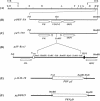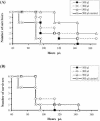Novel recombinant parapoxvirus vectors induce protective humoral and cellular immunity against lethal herpesvirus challenge infection in mice
- PMID: 12915547
- PMCID: PMC187421
- DOI: 10.1128/jvi.77.17.9312-9323.2003
Novel recombinant parapoxvirus vectors induce protective humoral and cellular immunity against lethal herpesvirus challenge infection in mice
Abstract
Orf virus (ORFV; Parapoxvirus ovis) was used to develop a novel vector system for the generation of effective and safe live vaccines. Based on the attenuated ORFV strain D1701-V, recombinants were produced that express the glycoproteins gC (D1701-VrVgC) or gD (D1701-VrVgD) of the alphaherpesvirus of swine, pseudorabies virus (PRV). Expression of gC and gD was also demonstrated on the surface of recombinant virus-infected murine cells that do not produce infectious ORFV. Single or combined immunization with the ORFV recombinants protected different mouse strains of a host species nonpermissive for ORFV against a fulminant, lethal PRV challenge infection equal to immunization with PRV live vaccine. Most notably, even a single immunization with D1701-VrVgC was protective, whereas two applications of D1701-VrVgD were required for immune protection. The higher protective capacity of D1701-VrVgC correlated with the induction of a strong specific humoral immune response. This suggestion was supported by transfer experiments using sera from recombinant-immunized mice, which resulted in partial gC but not gD antibody-mediated protection of the naïve recipients. Remarkably, immunization of different immune-deficient mice demonstrated that the application of the PRV gC-expressing recombinant controlled the challenge infection in the absence of either CD4(+) or CD8(+) T cells, B cells, or an intact perforin pathway. In contrast, D1701-VrVgD-immunized mice lacking CD4(+) T cells exhibited reduced protection, whereas animals lacking CD8(+) T cells, B cells, or perforin resisted the challenge infection. The present study demonstrates the potential of these new vector vaccines to efficiently prime both protective humoral and cell-mediated immune mechanisms in a host species nonpermissive for the vector virus.
Figures







Similar articles
-
Prime-boost immunization using DNA vaccine and recombinant Orf virus protects pigs against Pseudorabies virus (Herpes suid 1).Vaccine. 2006 Sep 11;24(37-39):6256-63. doi: 10.1016/j.vaccine.2006.05.078. Epub 2006 Jun 9. Vaccine. 2006. PMID: 16814432
-
A new rabies vaccine based on a recombinant ORF virus (parapoxvirus) expressing the rabies virus glycoprotein.J Virol. 2013 Feb;87(3):1618-30. doi: 10.1128/JVI.02470-12. Epub 2012 Nov 21. J Virol. 2013. PMID: 23175365 Free PMC article.
-
Comparison of different prime-boost regimes with DNA and recombinant Orf virus based vaccines expressing glycoprotein D of pseudorabies virus in pigs.Vaccine. 2010 Feb 17;28(7):1808-13. doi: 10.1016/j.vaccine.2009.12.004. Epub 2009 Dec 16. Vaccine. 2010. PMID: 20018271
-
Use of interleukin 12 to enhance the cellular immune response of swine to an inactivated herpesvirus vaccine.Adv Vet Med. 1999;41:447-61. doi: 10.1016/s0065-3519(99)80034-2. Adv Vet Med. 1999. PMID: 9890035 Review.
-
[Progress in the development of vaccines against Aujeszky's disease].Tierarztl Prax. 1995 Dec;23(6):570-4. Tierarztl Prax. 1995. PMID: 8585074 Review. German.
Cited by
-
Production and purification of high-titer OrfV for preclinical studies in vaccinology and cancer therapy.Mol Ther Methods Clin Dev. 2021 Aug 26;23:434-447. doi: 10.1016/j.omtm.2021.08.004. eCollection 2021 Dec 10. Mol Ther Methods Clin Dev. 2021. PMID: 34786436 Free PMC article.
-
Genomic Characterization of Orf Virus Strain D1701-V (Parapoxvirus) and Development of Novel Sites for Multiple Transgene Expression.Viruses. 2019 Jan 30;11(2):127. doi: 10.3390/v11020127. Viruses. 2019. PMID: 30704093 Free PMC article.
-
Orf Virus-Based Vaccine Vector D1701-V Induces Strong CD8+ T Cell Response against the Transgene but Not against ORFV-Derived Epitopes.Vaccines (Basel). 2020 Jun 10;8(2):295. doi: 10.3390/vaccines8020295. Vaccines (Basel). 2020. PMID: 32531997 Free PMC article.
-
Detection of anatid herpesvirus 1 gC gene by TaqMan fluorescent quantitative real-time PCR with specific primers and probe.Virol J. 2010 Feb 13;7:37. doi: 10.1186/1743-422X-7-37. Virol J. 2010. PMID: 20152046 Free PMC article.
-
Lentivirus expressing shRNAs inhibit the replication of contagious ecthyma virus by targeting DNA polymerase gene.BMC Biotechnol. 2020 Mar 23;20(1):18. doi: 10.1186/s12896-020-00611-4. BMC Biotechnol. 2020. PMID: 32293394 Free PMC article.
References
-
- Ben Porat, T., J. M. DeMarchi, B. Lomniczi, and A. S. Kaplan. 1986. Role of glycoproteins of pseudorabies virus in eliciting neutralizing antibodies. Virology 154:325-334. - PubMed
-
- Bianchi, A. T., H. W. Moonen-Leusen, F. J. van Milligen, H. F. Savelkoul, R. J. Zwart, and T. G. Kimman. 1998. A mouse model to study immunity against pseudorabies virus infection: significance of CD4+ and CD8+ cells in protective immunity. Vaccine 16:1550-1558. - PubMed
-
- Brenner, G. J., N. Cohen, and J. A. Moynihan. 1994. Similar immune response to nonlethal infection with herpes simplex virus-1 in sensitive (BALB/c) and resistant (C57BL/6) strains of mice. Cell. Immunol. 157:510-524. - PubMed
-
- Büttner, M., and H. J. Rziha. 2002. Parapoxviruses: from the lesion to the viral genome. J. Vet. Med. B Infect. Dis. Vet. Public Health 49:7-16. - PubMed
-
- Cooney, E. L., A. C. Collier, P. D. Greenberg, R. W. Coombs, J. Zarling, D. E. Arditti, M. C. Hoffman, S. L. Hu, and L. Corey. 1991. Safety of and immunological response to a recombinant vaccinia virus vaccine expressing HIV envelope glycoprotein. Lancet 337:567-572. - PubMed
Publication types
MeSH terms
Substances
LinkOut - more resources
Full Text Sources
Other Literature Sources
Research Materials
Miscellaneous

